How Traffic Lights Became Stages: Street Performers and the Urban Circus Culture of Latin America
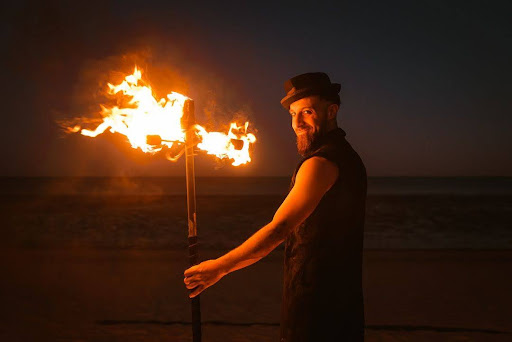
Original Version in Spanish below
I started my journey in the circus world ten years ago. At that time, there was a circus association in my city called Donyet Ardit, with which I began collaborating as an acrobatics trainer in a social circus project. The truth is, both the project and the people involved made me fall in love with this world. If you want to know more about this story, you can read the interview I gave to CircusTalk a couple of years ago. I go into more detail there. I’m telling you this now because as I began this research about the Faro, I remembered that a few years ago we made a short film to celebrate Circus Day. The short film was called “The Perfect Traffic Light” and it was about an ordinary day at an ordinary traffic light, where a wave of circus artists suddenly appeared to fill drivers with magic.
El Semáforo Perfecto – Dia Internacional del Circo – Alicante
It was a very fun activity in which several artists from my city participated, along with some artists from Faro and our social circus students.
Then I remembered that when I was in Mexico directing ELCIRCA, the Jalisco Circus School, I somehow found the time to shoot a music video starring Aldonza Orellana, about the traffic light, with the members of the Teatro Escombros collective. This short film was about a girl who sings at the traffic light and, to make her voice reach the cars, she uses a radio signal amplifier. I thought it was a good idea to explore ways to bring the artist closer to their audience. I believe there is still much to discover in the world of Faro artists.
En Rojo
Let me show you two more videos and I’ll wrap up the introduction. Just wait, you’re going to love it. While working on the first part of this article, I decided to ask my followers on Instagram for their opinions, knowing that many of them are street artists. What I didn’t expect was the flood of reflections, stories, and even debates that this post provoked.
Among all the comments, the title “The Traffic Light Society” appeared several times. It’s a 2010 film written and directed by Rubén Mendoza. The movie, based on true events, is about a street recycler who hacks traffic lights so that the red light lasts longer, allowing him and other characters to take advantage of the “traffic light economy.” The film depicts this underworld in a very special way, showing the harsh reality of the streets of Colombia.
La sociedad del semáforo Película completa | Tráiler | Disponible en RTVCPlay
Finally, to wrap up this introduction, I’m going to tell you about another documentary I discovered thanks to the comments on that post. It’s called Come, Laugh, Enjoy. This time, it’s directed by Mauricio Orellana Diaz, a Chilean juggler and anthropologist who took advantage of his own journey through Latin America to analyze the lives of street artists. It’s a much more personal documentary, with a more explanatory approach than the previous film, but it has the strength of a story about a journey through the voices of traveling artists who traverse Latin America.
Venid, Reid, Gozad
Alright, now we’re ready. Let’s begin.
Reflections from El Faro

The traffic light gave me so much. For me, the Faro is a fleeting urban stage. It’s quite a challenge; you have about a minute to amaze an audience that just wants to get home. It’s truly a magical place when you manage to make someone smile or surprise a grumpy adult. While collaboration is necessary, even more important is the attention and appreciation for the art you bring. Because, even if it’s on the street and only for a minute, it’s still an art form to create astonishment and also make a living from it.– Mati Duende
I open with this quote from Mati Duende, a juggler and clown I met at La Conve in Uruguay. It struck me as so sincere and profound that it somehow encapsulates the essence of what I’ve heard from many other street artists in Faro across Latin America.
In the previous article, I tried to explain the material conditions that gave rise to the Faro as an urban artistic phenomenon. But I’m aware that I’m not an active part of that movement. My perspective is partial. That’s why I believe the best way to explain this new form of artistic expression—so specific, so complex—is to do it through those who make it possible. This article will be a collection of reflections from those who have dedicated themselves to the Faro and made it their life.
Mati’s story is quite common among street artists: the Faro was a tool through which they learned to be artists. It’s probably the most hostile stage that exists, not just because it’s in the street, but because it happens precisely in an environment where art is not expected. The grumpy drivers are you and me, behind the wheel, on any given day: stressed, focused, in a hurry, listening to a podcast or thinking about everything that needs to be done. Suddenly, in that space of routine and pressure, someone appears trying to catch my attention. It’s going to be tough. My day has been hard. I don’t have time for this. I didn’t choose to be an audience member.
And yet, sometimes, the artist catches my attention. Their routine, repeated a thousand times (once a minute for hours, every day), fascinates me. And, for a minute, I’m not a grumpy driver; I’m an audience. And that can be a gift.
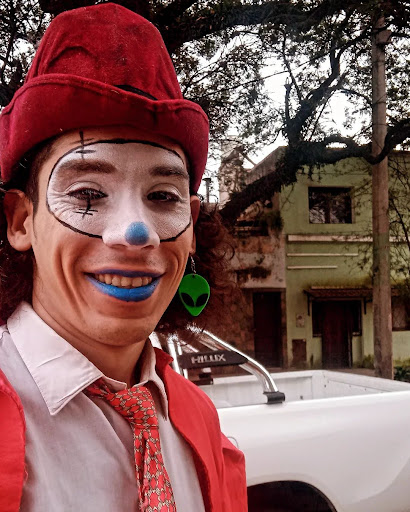
The traffic light is the way out for artists of lower status… It’s an opportunity not only for expression, trial and error, but also for work (the only place where rehearsals are paid). The traffic light opened the doors for me to fully dedicate myself to art, not as a hobby, but as a profession. It’s also a popular space where everyone can be touched by art and break their routine, regardless of whether they have money to buy a ticket or not. Street art finds its way into any space, but at the traffic light, it’s pure glory. 🙌💚
– Ignacio Abrigato
Ignacio is a circus artist, actor, teacher, and theater director. He’s a very interesting person whom you can follow on social media (@nano_actor) and who has quite a groundbreaking perspective.
There was some controversy over his first statement, “the traffic light is the way out for artists of lower status.” Some street artists argued that being poor is not the same as being an artist of low status. He agreed with them. He meant “of low economic status.” Perhaps this nuance is not as clear in English, but it’s quite important. There is a prejudice against people who work on the street, assuming they are of a lower artistic level compared to those who perform in tents or festivals. This is not always the case. I’ve seen traffic light routines that reach an incredible technical level. Routines that you would never see under a big top because, as Ignacio says, the traffic light is the only place where rehearsals are paid. And it’s true. Every time the light turns red, a good artist can earn money, even if it’s just a few coins. That’s an incentive that doesn’t exist in other environments.
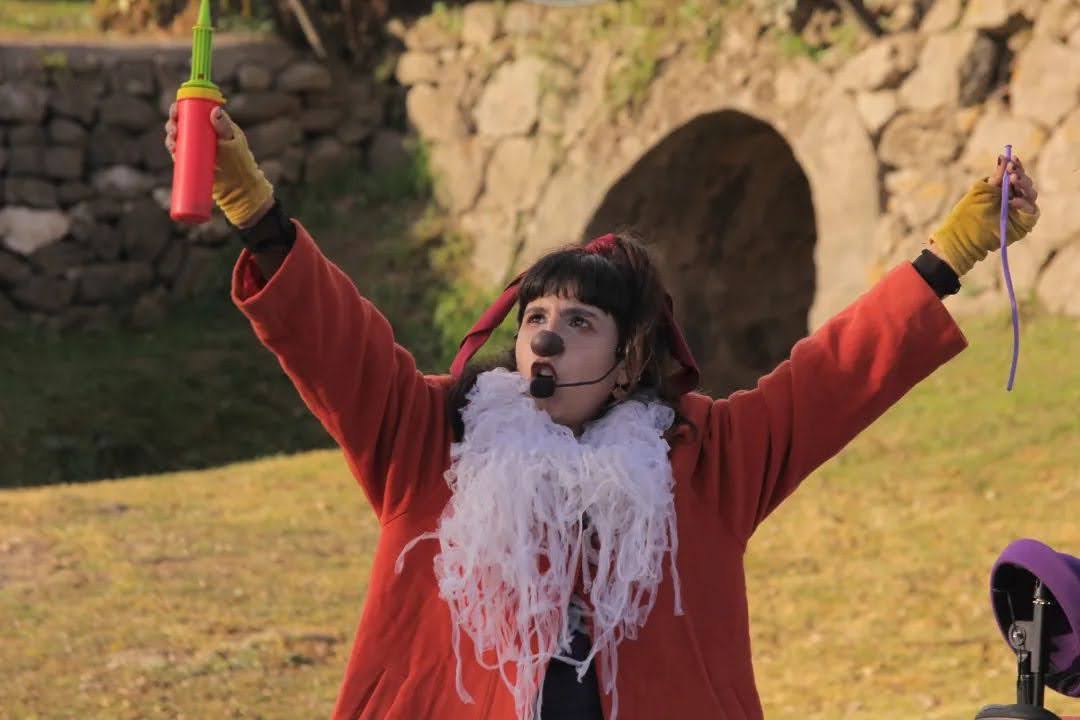
For me, circus at the traffic light is one of the most anarchic forms of expression within the performing arts. It’s an economic tool for traveling and a source of comfort and entertainment for the spectators, who bear the burden of their daily routine.
– Cata Dinoto
Cata Dinoto (@mamonapayasa) is a street artist, clown, musician, mother, cultural manager, and producer. I appreciate that ideological identification: one of the most anarchic forms of expression within the performing arts. I could write at length about counterculture, anarchy, and how the system has absorbed much of the discourse in the performing arts.
If we adhere to Marshall McLuhan’s insightful thesis, “the medium is the message,” the traffic light, as a medium, redefines the meaning of art and public space, providing a stage for cultural resistance and artistic expression in a world governed by the rules of traffic and efficiency. It’s for everyone. It respects minimal rules, adapting to complexity while still being free. And that, to me, is pure anarchy.
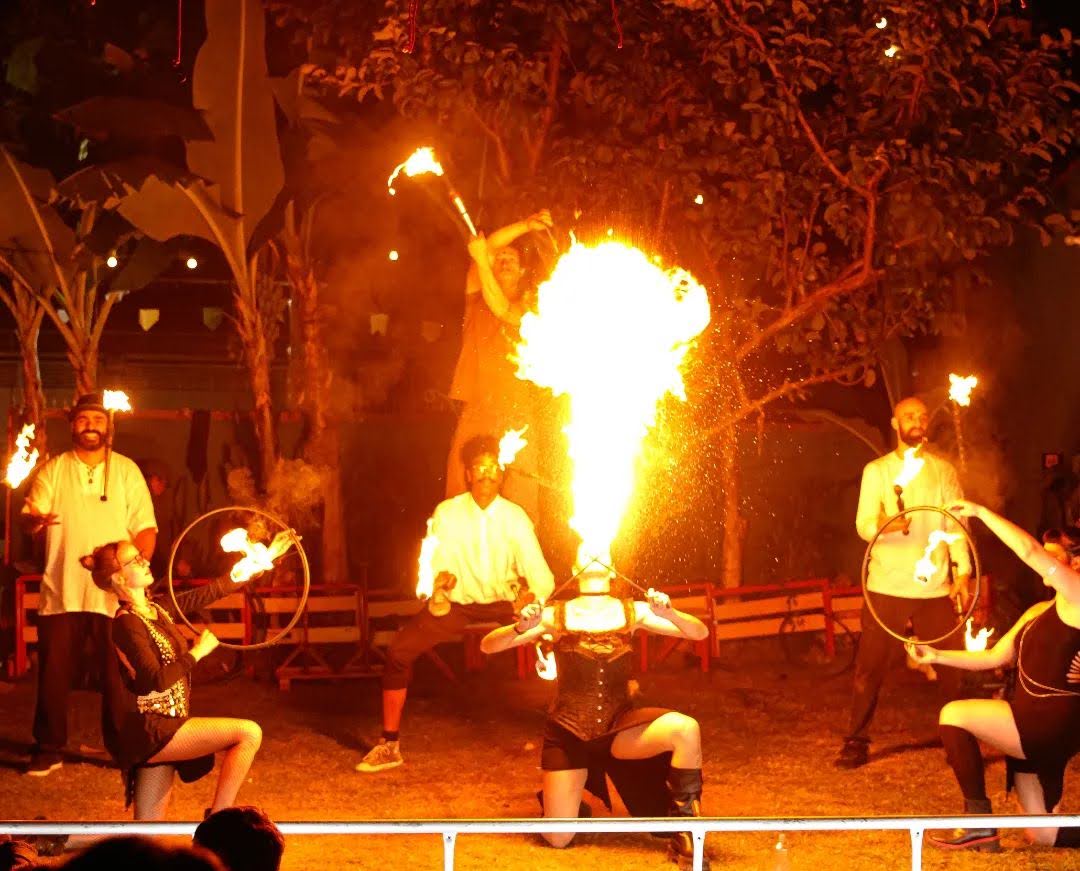
For me, the traffic light was something that pulled me out of the economic instability I was experiencing at that time and became a source of inspiration to create characters and blend them with movement. Moreover, something special happens: you manage to evoke something in people, whether they shout, applaud, throw coins at you, make fun of you, or even give you gifts.
– Jessica Terra
Jessica Terra (@dionisiaterra) is a Brazilian circus artist from Cia. Pirilampos. Her story is quite common within the traffic light performer community. For many artists, the traffic light is a way to make a living. Many who have ended up working professionally in the circus (in tents, with international companies, etc.) have gone through the traffic light stage. It’s like a phase—sometimes longer, sometimes shorter. There are probably those who dedicate their entire artistic careers exclusively to performing at traffic lights; I haven’t met many with that profile, but I don’t doubt they exist. The traffic light allows them to earn the money you need to travel and, at the same time, serves as a trial-and-error laboratory. It allows you to experiment, try out characters, test new tricks, and learn different elements (especially juggling), but most importantly, it exposes you. As the director of a well-known circus school once said, “a circus artist is made on stage.”
I see a certain romanticization of the traffic light… Once, I was almost run over by a man on a motorcycle who ran the red light, and I shouted, “Watch out, it’s red!” At that moment, a man walked by and told me that if I got run over, it would be my fault for using the traffic light to clown around and not to cross the street. That’s when I realized the precarious and neglected situation I was in. Another thing is dealing with people’s boredom and becoming part of the urban landscape.
– Damian Salguero
Not everything is magic and rainbows. The traffic light is a dangerous place. Damian Salguero (@damy.show) is a street artist who has been exposing himself and sharing his skills both at the traffic light and on various stages for years. The truth is that the streets in general, and those in Latin America in particular, are not safe places. Hit-and-runs, robberies, and even direct attacks, like the tragedy that happened in Chile a few years ago, where police shot and killed Francisco Martínez Romero a traffic light artist, which led to massive protests throughout the community. These dramatic events reveal the dangers inherent in this stage. When I say it’s one of the toughest stages in the world, I believe I’m not far from the truth.
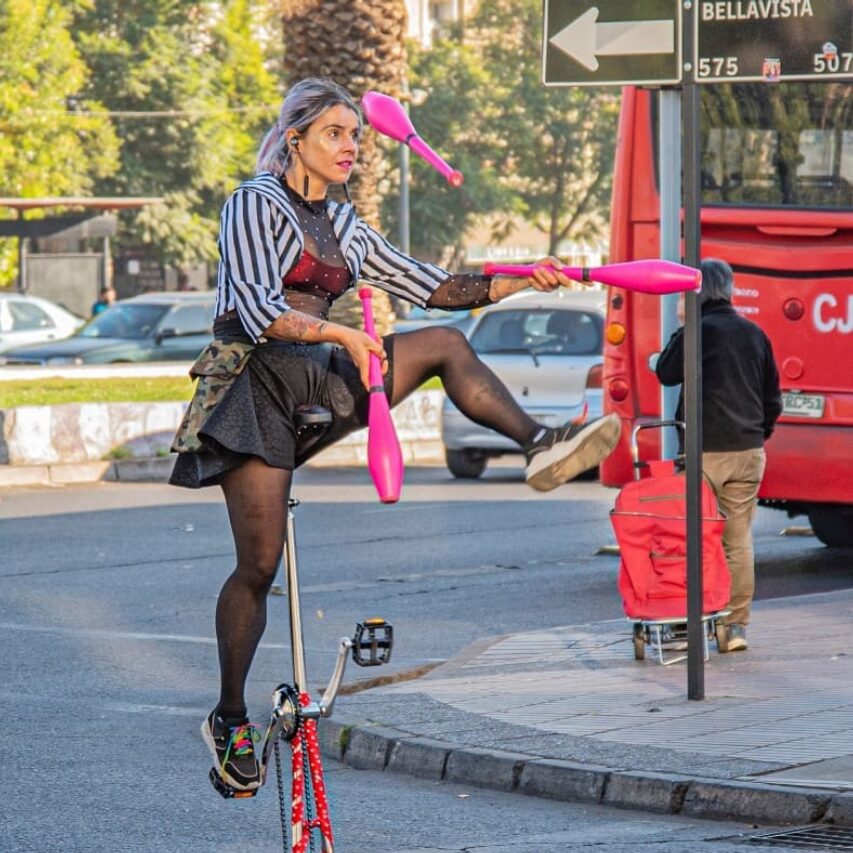
The traffic light was red, and I wasn’t there to cross. My whole body was trembling, and my hands were sweating. I barely knew three tricks, which I timidly mastered. It was 8 p.m., and it was dark. I looked around several corners and chose the biggest one; my lit chains were ready for some swinging. I thought my forehead was sweating because of the heat from the torches, but the fire was inside me. Back then, performing at the traffic light was an additional activity to my job; shortly after, it became my moral, emotional, and financial lifeline. At the traffic light, I found self-love, I found love, I met my partner, and thanks to the traffic light, I built a large part of who I am today. Thank you, @ambulante_circo, for coming into my life 😌🙏. Thank you for so much inspiration, thanks to you I have discovered juggling and circus in a way I never knew before.
– Carolina
Carolina (@aji_confitado_chilensis) is a Chilean juggler who discovered the circus 12 years ago. According to her, the traffic light gave her everything. “The street holds the truth of life,” she says. She is able to capture that essence I have seen in many artists. Explaining why one would dedicate themselves to this form of art is complicated. There are too many prejudices at times. Now, she focuses on events and shows, perfecting what she learned at the traffic light.
As a final thought, I’d like to share a short poem Carolina gave me:
While everyone crosses,
the artist stays behind.
Conclusion
I want to thank everyone who shared their reflections, concerns, and critiques about the traffic light with me. I hope I’ve contributed, even if just a little, to giving visibility to this way of doing circus. It’s not all about tents, it’s not all about enclosed stages. Street art existed long before tents, long before spotlights. I like to think of art as nature—wild, unapologetic, unextinguishable; like that little flower growing in the crack of the asphalt.
I like to think that no matter how gray the world may be, we will find a way to create art. Because that’s what we came here to do, in this fleeting breath that is life.
El semáforo: el escenario del siglo XXI (parte 2)
Comencé mis andaduras en el mundo del circo hace diez años. Por aquel entonces había una asociación de circo en mi ciudad, que se llamaba Donyet Ardit, con la que empecé a colaborar como formador de acrobacias en un proyecto de circo social. La verdad es que tanto el proyecto como la gente hizo que me enamorara de este mundo. Si quieres saber más de esta historia, puedes leer la entrevista que me hicieron en CircusTalkhace un par de años. Ahí profundizo más.
Pero te la cuento ahora porque al iniciar esta investigación sobre el Faro me acordé de que hace unos años hicimos un corto para celebrar el día del circo. El corto se titulaba “El Semáforo Perfecto” y trataba de un día cualquiera, en un semáforo cualquiera, en el que aparecía una avalancha de artistas de circo a llenar de magia a los conductores.
El Semáforo Perfecto – Dia Internacional del Circo – Alicante
Fue una acción muy divertida en la que participaron varios artistas de mi ciudad, algunos artistas de Faro y también nuestro alumnado de circo social.
Luego me acordé de que cuando estaba en México dirigiendo ELCIRCA, la Escuela de Circo de Jalisco, no sé cómo saqué tiempo para grabar un videoclip, protagonizado porAldonza Orellana, sobre el semáforo, con los compañeros del colectivo Teatro Escombros. Este corto iba sobre una chica que canta en el semáforo y que, para que su voz llegue a los autos, usa un amplificador de señal de radio. Me parecía una buena idea la de investigar formas de acercar al artista a su público. Creo que hay mucho por descubrir aún en el mundo de los artistas de Faro.
En Rojo
Te enseño dos videos más y termino la introducción. Solo espera, te va a encantar.
Al hacer la primera parte de este artículo, se me ocurrió pedir la opinión de mis seguidores en instagram, sabiendo que muchos de ellos son artistas de calle. Lo que no me esperaba fue el aluvión de reflexiones, historias e incluso debates que provocóaquella publicación.
Entre todos los comentarios, apareció varias veces el título “La Sociedad del Semáforo”, una película del 2010, escrita y dirigida porRubén Mendoza. La película, basada en hechos reales, trata de un reciclador de la calle que hackea los semáforos para que la luz roja dure más tiempo, lo que le permite a él y a otros personajes aprovecharse de la economía del semáforo. La película retrata de una forma muy especial este submundo, desde la cruda realidad de las calles de Colombia.
La sociedad del semáforo Película completa | Tráiler | Disponible en RTVCPlay
Por último, para cerrar esta introducción, te voy a hablar de otro documental que descubrí gracias a los comentarios de aquella publicación. Se llama Venid, Reid, Gozad. Esta vez está dirigida porMauricio Orellana Diaz, un malabarista y antropólogo chileno, que aprovechó su propio viaje por latinoamérica para analizar la vida de los artistas callejeros. Es un documental mucho más personal y con una vocación más explicativa que la película anterior, pero tiene la potencia de la historia de un viaje a través de las voces de artistas viajeros, que recorren latinoamérica.
Venid, Reid, Gozad
Vale, ahora sí. Empezamos.
Reflexiones del Faro

El semáforo me dio tanto. Para mi el Faro es un escenario urbano y fugaz. Es todo un desafío, tienes alrededor de un minuto para sorprender al espectador que solo quiere llegar a su casa. Es realmente un lugar mágico cuando logras hacer sonreír o sorprender sobre todo a un adulto malhumorado. Ya la colaboración si bien es necesaria más necesaria es la atención la valoración del arte que uno lleva. Ya que aunque sea en la calle y sea un minuto, no deja de ser un arte el hecho de generar sorprendimiento y aparte vivir de ésto. –Mati Duende
Abro con esta frase deMati Duende, un malabarista y clown que conocí enLa Conve de Uruguay, que me pareció tan sincera y profunda, que de alguna forma resume la esencia de lo que he ido escuchando a otros muchos artistas de Faro de latinoamérica.
En el anterior artículo intenté explicar las condiciones materiales que propiciaron el origen del Faro como fenómeno artístico urbano. Pero soy consciente de que yo no formo parte activa de ese movimiento. Mi visión es parcial. Por eso, creo que la mejor manera de explicar esta nueva forma de expresión artística, —tan concreta, tan compleja—, es hacerlo a través de quienes la hacen posible. Este artículo va a ser una recopilación de reflexiones de quienes se han dedicado al Faro y que han hecho de él su vida.
La historia de Mati es bastante común entre los artistas callejeros: el Faro fue una herramienta con la que aprendieron a ser artistas. Probablemente sea el escenario más hostil que exista, no solo porque es en la calle, sino porque sucede precisamente en un entorno donde no se espera que haya arte. Losconductores malhumoradossomos tú y yo, al volante, cualquier día: estresados, concentrados, con prisa, escuchando un podcast o pensando en todo lo que hay que hacer. De repente, en ese espacio de rutina y presión, aparece alguien que pretende captar mi atención. Va a ser difícil. Mi día ha sido duro. No tengo tiempo para esto. No he decidido ser espectador.
Y aún así, a veces, el artista llama mi atención. Su rutina, repetida mil veces (una vez por minuto durante horas, cada día) me fascina. Y, por un minuto, no soy un conductor malhumorado, soy un espectador. Y eso puede llegar a ser un regalo.

El semáforo es la salida que tenemos los artistas de baja condición… Es una oportunidad no solo de expresión, prueba y error, sino también laboral (el único lugar donde pagan los ensayos). El semáforo me abrió las puertas para dedicarme al arte de manera íntegra y completa, no como un hobby, sino como una profesión. Es además un lugar popular donde todos pueden contagiarse del arte para cambiar un poco su rutina, más allá de si tienen plata o no para pagar una entrada. El arte callejero encuentra sus formas en cualquier espacio, pero en el semáforo es la gloria 🙌💚 –Ignacio Abrigato
Ignacio es artista de circo, actor, profesor y director de teatro. Es un personaje super interesante que puedes seguir por sus redes sociales (@nano_actor) y que tiene un discurso bastante rompedor.
Hubo cierto revuelo por su primera frase “el semáforo es la salida que tenemos los artistasde baja condición”.Algunos artistas callejeros le recriminaron que no es lo mismo ser pobre que ser un artista de baja condición. Él les dió la razón. Quería decir “de baja condición económica”. Quizás en inglés no se entienda el matiz, pero es bastante importante. Hay un prejuicio con las personas que trabajan en la calle y es que se da por hecho que son de un nivel artístico inferior que aquellos que se presentan en carpa, o en festivales. Esto no es siempre así. He visto rutinas de semáforo que llegan a un nivel técnico increíble. Rutinas que nunca verás bajo una carpa ya que, como dice Ignacio, (el faro es)el único lugar donde pagan los ensayos. Y no deja de ser cierto. Cada vez que la luz se pone en rojo, el buen artista puede cobrar. Aunque sean unos pesos. Eso es un incentivo que no existe en otros ámbitos.

El circo en el semáforo, para mí, es una de las expresiones más anárquicas dentro de las artes escénicas. Es una herramienta económica para viajar y una caricia y entretenimiento para lxs espectadores, quienes cargan con el tedio de la rutina. –Cata Dinoto
Cata Dinoto(@mamonapayasa) es artista callejera, payasa, música, mamá, gestora y productora cultural. Me gusta esa identificación ideológica:una de las expresiones más anárquicas dentro de las artes escénicas. Podría escribir largo y tendido sobre la contracultura, la anarquía y cómo el sistema ha absorbido gran parte de los discursos en las artes escénicas. Pero si nos acogemos a la acertada tesis deMarshall McLuhan “el medio es el mensaje”, el Faro, como medio, redefine el sentido del arte y el espacio público, proporcionando un escenario para la resistencia cultural y la expresión artística en un mundo regido por las normas del tráfico y la eficiencia. Es para todos. Respeta unas normas mínimas, adaptándose a la complejidad y al mismo tiempo es libre. Y eso, para mí, eso es anarquía pura.

Para mí, el semáforo fue algo que me sacó de la inestabilidad económica en la que me encontraba en ese momento y se convirtió en una fuente de inspiración para crear personajes y fusionarlos con el movimiento. Además, sucede algo especial: logras despertar algo en las personas, ya sea que griten, aplaudan, te lancen monedas, se burlen o incluso te regalen cosas. –Jessica Terra
Jessica Terra (@dionisiaterra), es una artista de circo brasileña de lacia. Pirilampos. Es algo bastante común su historia, dentro de la comunidad de semaforistas. Para muchos artistas el Faro es una forma de ganarse la vida. Muchos de quienes se han acabado dedicando profesionalmente al circo (de carpa, en compañías internacionales, etc.) han pasado por el faro. El faro es algo así como una etapa, a veces más larga, a veces más corta. Probablemente haya quienes se dedican exclusivamente a hacer Faro durante toda su carrera artística, yo no he conocido a muchos con ese perfil, pero no dudo que los haya. El Faro te permite ganar el dinero con el que puedes viajar y al mismo tiempo sirve como un laboratorio de prueba y error. Te permite experimentar, probar personajes, probar trucos nuevos, aprender distintos elementos (sobretodo de malabares) pero, sobretodo, te expone. Como decía un director de una escuela de circo muy conocida, “el artista de circo se hace sobre el escenario”.
Al leer los comentarios, veo cierta romantización del semáforo… Una vez casi me atropelló un hombre en moto que se pasó el 🚦 en rojo, y yo le dije “¡Cuidado, está en rojo!”. En ese momento, pasó un señor y me dijo que si me atropellaban era culpa mía por usar el semáforo para hacer payasadas y no para cruzar. Ahí comprendí la situación precaria y de abandono en la que me encontraba. Otra cosa es enfrentar el tedio de la gente y convertirse en parte del paisaje urbano. –Damian Salguero
No todo es magia y color de rosa. El semáforo es un lugar peligroso. Damian Salguero (@damy.show) es un artista callejero que lleva años exponiéndose y compartiendo sus habilidades tanto en el faro como en distintos escenarios. Lo cierto es que las calles en general y las de latinoamérica en particular no son un lugar seguro. Atropellos, atracos, incluso ataques directos, como la tragedia que sucedió en Chile hace unos años, donde unos policías dispararon a matar aFrancisco Martínez Romero, un artista de Faro, lo que provocó unas protestas masivas en toda la comunidad. Estos eventos tan dramáticos, nos dejan ver el peligro que entraña este escenario. Cuando digo que es uno de los escenarios más difíciles del mundo, creo que no estoy muy alejado de la realidad.

El semáforo estaba en rojo y yo no estaba ahí para cruzar. Mi cuerpo entero temblaba y mis manos sudaban. Apenas conocía tres trucos que dominaba tímidamente. Eran las 8 y estaba oscuro. Miré varias esquinas y elegí la más grande; mis cadenas encendidas estaban listas para hacer swing. Creí que mi frente sudaba por el calor del fuego de las antorchas, pero el fuego lo llevaba dentro. En ese entonces, el semáforo era para mí una actividad adicional a mi trabajo; poco tiempo después se convirtió en mi salvavidas moral, emocional y económico. En el semáforo encontré amor propio, encontré el amor, conocí a mi pareja y, gracias al semáforo, construí gran parte de lo que hoy soy. Gracias, @ambulante_circo, por aparecer en mi vida 😌🙏. Gracias por tanta inspiración, gracias a ustedes he descubierto el malabar y el circo de una forma que no conocía. –Carolina
Carolina(@aji_confitado_chilensis) es una malabarista chilena que encontró el circo hace 12 años. Según ella el semáforo le dió todo, “La calle tiene la verdad de la vida”, dice. Ella es capaz de sintetizar esa esencia que he visto en varios artistas. Explicar por qué dedicarse a esa forma de arte es complicado. Hay demasiados prejuicios a veces. Ahora se dedica a hacer eventos y shows, perfeccionando lo aprendido en el Faro.
Como frase final me gustaría compartirte un pequeño poema que me regaló Carolina:
Mientras todos cruzan,el artista se queda.
Conclusión
Quiero agradecer a todas las personas que me han compartido sus reflexiones, sus inquietudes, sus críticas sobre el Faro. Me gustaría haber colaborado, aunque sea un poco, en dar visibilidad a esta forma de hacer circo. No todo son carpas, no todo son escenarios cerrados. El arte en la calle existía mucho antes que las carpas, mucho antes que los focos. Me gusta pensar en el arte como en la naturaleza, rabiosa, impune, inextinguible; como esa florecita que crece en la grieta del asfalto.
Me gusta pensar que por más gris que sea el mundo, encontraremos la forma de hacer arte. Porque es lo que hemos venido a hacer aquí, este suspiro que es la existencia.
All photos provided by Miguel Manzano
Back to Home
urban circus urban circus urban circusurban circus
Editor's Note: At StageLync, an international platform for the performing arts, we celebrate the diversity of our writers' backgrounds. We recognize and support their choice to use either American or British English in their articles, respecting their individual preferences and origins. This policy allows us to embrace a wide range of linguistic expressions, enriching our content and reflecting the global nature of our community.
🎧 Join us on the StageLync Podcast for inspiring stories from the world of performing arts! Tune in to hear from the creative minds who bring magic to life, both onstage and behind the scenes. 🎙️ 👉 Listen now!
